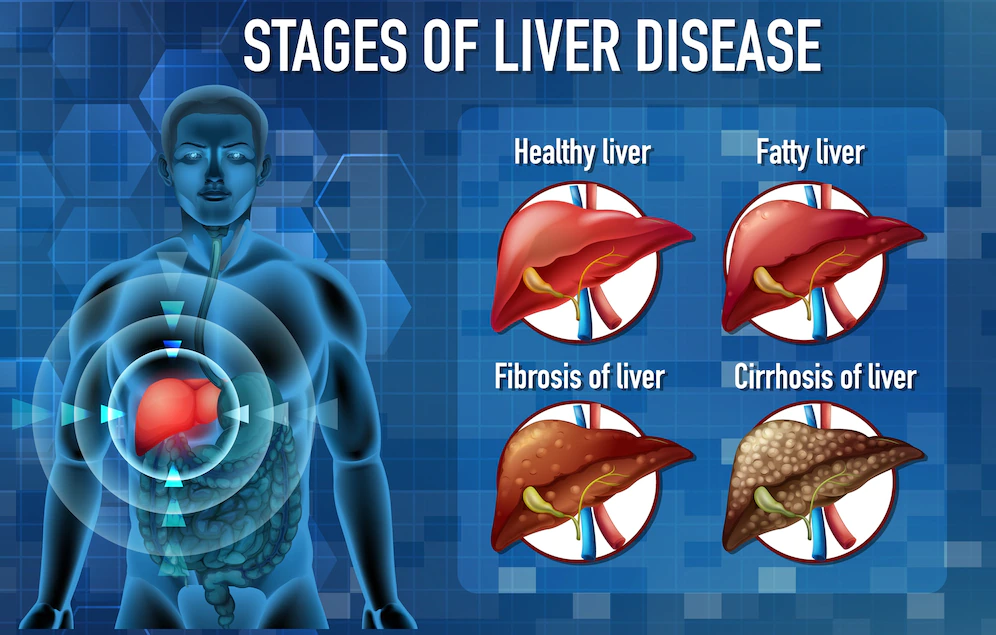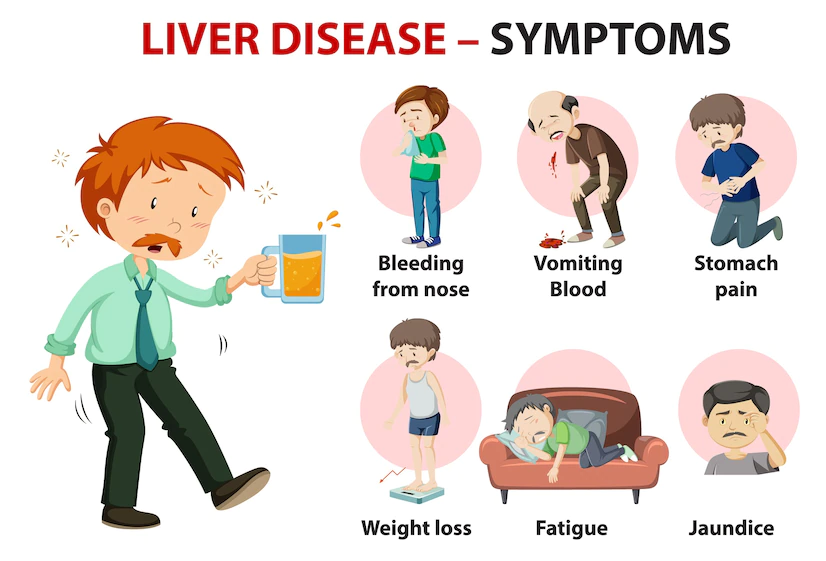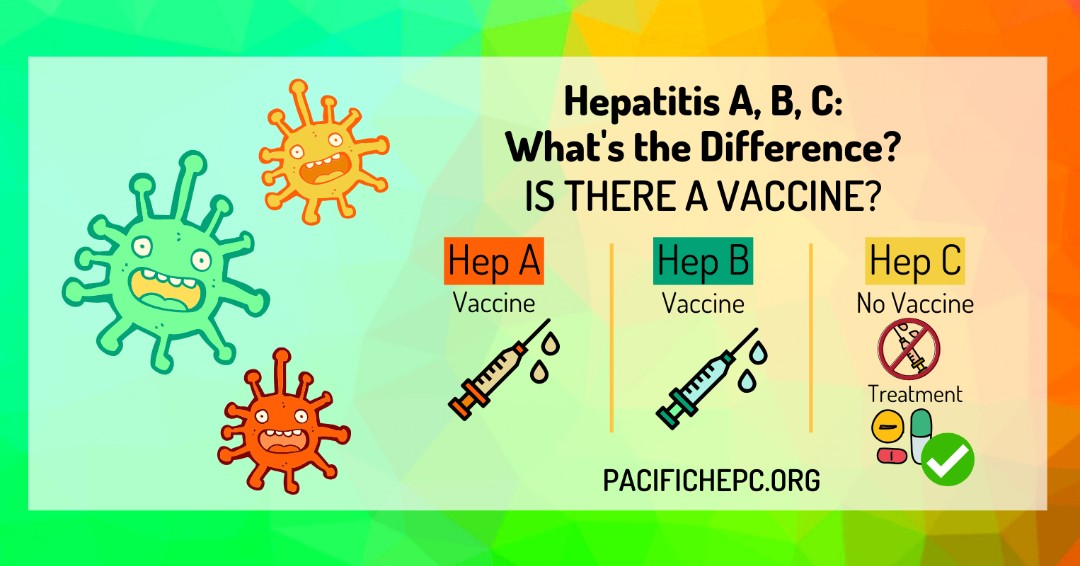The liver is one of the most important organs in the body as it helps in performing more than 500 vital functions in the body. It is responsible for the removal of toxins from the blood, the breakdown of harmful substances like alcohol and drugs, and the storage of different vitamins. The normal functioning of the liver is also essential for proper digestion as the liver produces a substance called bile which is responsible for the breakdown of different fats that we consume daily.
Table of Content
1. What is liver disease?
2. What are the causes of liver diseases?
3. What are the symptoms of Liver disease?
4. What are the Four Stages of Liver diseases?
5. Takeaway
What is liver disease?
A variety of factors can harm the liver and cause it to malfunction. Liver disease is defined as any condition that has a negative impact on the liver and interferes with its normal day-to-day functioning. More than 100 different types of liver diseases from infections to Cirrhosis or scarring have been diagnosed in people. When a person suffers from liver diseases, all the normal functioning of the liver is affected resulting in several health problems. This can not only harm the liver but also affect other organs and tissues.
Most liver disease starts and proceeds through multiple phases. As liver disease progresses, scarring starts in the healthy liver cells resulting in improper functioning of the liver.
The early stages of liver disease are easier to treat and manage but if left untreated, they can progress to advanced stages and lead to severe complications like liver cancer.
If you notice any symptoms of liver problems or suspect anything, consulting an experienced gastroenterologist is always recommended.
What are the causes of liver diseases?
Many factors can affect the liver and its normal functioning. Some of the most common causes of Liver disease are:
- Poor lifestyle and diet: Unhealthy lifestyle and a poor diet are one of the leading causes of liver diseases.
- Obesity: Excessive weight gain and fat deposition around the organs are other major causes of problems with the liver. Generally, It is seen that people who have a BMI of over 25 are generally more prone to developing liver disease due to excessive fat deposits. The consumption of too much fat can result in a condition known as nonalcoholic fatty liver disease.
- Infections: several viral infections have been linked to liver damage. Hepatitis A, B, and C are among the most prevalent viral infections affecting the liver. If left untreated, viral infections cause substantial liver damage.
- Cancer: the formation of tumours and abnormal cells in the liver is another cause of liver disease. Benign or malignant liver cancers might worsen over time and adversely influence liver functioning.
- Toxin consumption: alcohol misuse is one of the primary causes of level failures. Alcoholic fatty liver disease is a disease induced by the intake of excessive alcohol.
- Heredity or genetics: Many times the cause behind developing liver diseases is hereditary or genetics. If either of your parents has a liver condition such as Wilson’s disease or hemochromatosis, you are more likely to acquire this liver disease.
What are the symptoms of Liver disease?
When it comes to symptoms, conditions such as nonalcoholic fatty liver disease do not have any symptoms initially. Other conditions do have some common symptoms of Liver disease that can help in the diagnosis:
- Jaundice: it is a disorder that is characterised by excessive yellowing of the skin and eyes. Jaundice develops when the liver is unable to eliminate the substance known as bilirubin. Elevated bilirubin levels cause yellowing of the skin, urine and eyes.
- Abdominal pain: Another common symptom that patients have is abdominal pain. This pain is generally felt on the right side of the abdomen where the liver is located.
- A change in the colour of urine or stool: The pigments bilirubin and biliverdin produced by the liver give the characteristic colour to the urine and faeces. There is a change in the colour of urine or faeces when there is a problem with the liver. For example conditions like jaundice can lead to excessive yellow urine.
- Swelling
- Nausea
- Vomiting
What are the Four Stages of Liver diseases?
Liver diseases are classified into different stages based on how far the disease has progressed and the damage that has already been done to the live tissues. There are four stages of liver diseases, beginning with:
Stage 1: Inflammation
- The initial stage of liver disease is inflammation, which causes oedema and liver enlargement. It is the body’s initial reaction to an injury or infection.
- Inflammation of the liver can also be caused by a viral infection or a buildup of toxins in the blood. If this inflammation is diagnosed at an early stage it can be treated easily with the help of medications and other treatments. Untreated inflammation can progress to the next stages of liver disease and can cause permanent damage.
Stage 2: Fibrosis
- Untreated liver inflammation can result in scar tissue formation in the liver, known as fibrosis.
- The healthy liver cells are replaced by scar cells when fibrosis occurs
- The growing scar tissue impairs the liver’s capacity to maintain normal blood flow and function properly. This usually causes damage to the surrounding tissues.
Stage 3: Cirrhosis
- The next stage of liver disease is cirrhosis, which is distinguished by severe scarring in the liver. Cirrhosis, or the third stage of liver disease, is characterised by jaundice, pain, discomfort, extreme tiredness, and an itching feeling around the liver.
- The advancement from the second to the third stage might take longer. Therefore early identification is critical.
Stage 4: Liver failure
Liver Failure is the last stage of liver disease in which all of the liver’s functions stop, resulting in liver failure.
Liver Failure is often divided into two categories: acute and chronic.
- In acute liver failure, the liver reacts to a drug overdose or toxicity.
- In the case of chronic liver failure, the steady progression of liver disorders occurs, and the liver will eventually fail. Weight loss, diarrhoea, disorientation, and confusion are frequent signs of end-stage liver failure.
At this point, treatment is no longer an option, and the only viable alternative for recovery is a liver transplant.
Takeaway
The liver is the most important organ in the digestive system and the body. It is not simple to live with liver conditions. Liver diseases need appropriate treatment and medical care. Early identification of liver problems can aid in good, long-term management. In the event of any symptoms, a consultation with a gastroenterologist such as Dr. Piyush Ranjan is advised.
Dr. Piyush is a highly qualified best liver doctor in Delhi with years of expertise in treating various liver ailments and preventing liver disease.





